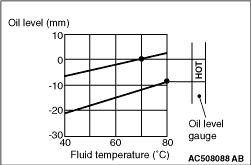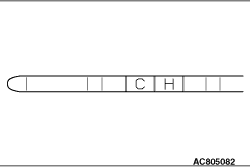
|
1.Drive the vehicle until the CVT fluid is warmed up to the normal operating temperature
(70 to 80°C).
| note |
Use M.U.T.-III. to measure the CVT fluid temperature.
|
| note |
When a certain amount of time is required to warm up the CVT fluid to the normal operating
temperature (70 to 80°C), check the oil level referring to the characteristics chart.
|
2.Park the vehicle on a level surface.
3.Move the selector lever to every position to fill the torque converter and the hydraulic
circuit with the CVT fluid, and then move the selector lever to "P" or "N" range.
4.Wipe clean the area around the oil level gauge, and then remove the oil level gauge
to check the condition of the CVT fluid.
| note |
If the CVT fluid smells burnt or is excessively deteriorated or dirty, the CVT fluid is
contaminated with particles of the metal bushings and friction material. In these cases, the
transmission must be overhauled.
|
|

|
5.Check that the CVT fluid level is within the "HOT" area on the oil level gauge. If the
fluid level is low, add the CVT fluid to the "HOT" level.
CVT fluid: MITSUBISHI MOTORS GENUINE CVTF-J4
| note |
When the CVT fluid level is low, the oil pump sucks air together with the CVT fluid, and
produces air bubbles in the hydraulic circuit. The air bubbles in the hydraulic circuit decreases
the hydraulic pressure, causing the delayed gearshift or slippage of the belt, clutch, and brake.
When the CVT fluid level is too high, the fluid is stirred by the gear and foams up, and the
problems similar to those when the CVT fluid level is low will occur. In either case, air bubbles
cause the overheat and oxidation of the CVT fluid, which prevents normal operation of the valve,
clutch, and brake. Beside, when the CVT fluid is foamy, it flows out of the transmission vent
hole. This may be taken as the fluid leakage by mistake.
|
6.Insert the oil level gauge securely.
|

